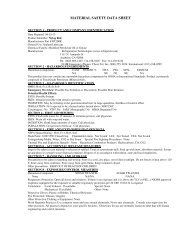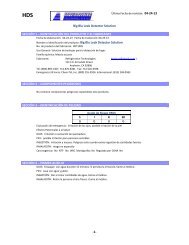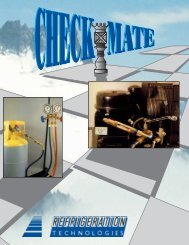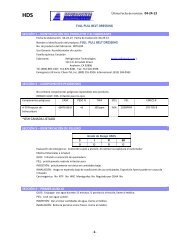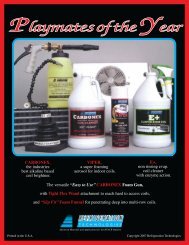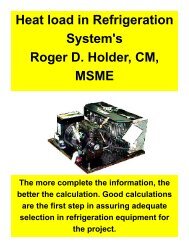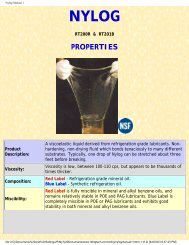Balancing of a Water and Air System (PDF
Balancing of a Water and Air System (PDF
Balancing of a Water and Air System (PDF
Create successful ePaper yourself
Turn your PDF publications into a flip-book with our unique Google optimized e-Paper software.
53<br />
Design below the 250°F limit (ASME low-pressure boiler code) must be considered.<br />
Figure 2 shows the flow variation when 90% terminal capacity is acceptable. Note that<br />
heating tolerance decreases with temperature <strong>and</strong> flow rates <strong>and</strong> that chilled-water<br />
terminal are much less tolerant <strong>of</strong> flow variation than hot-water terminals.<br />
Dual-temperature heating/cooling hydronic systems are sometimes first started during<br />
the heating season. Adequate heating ability in the terminals may suggest that the<br />
system is balanced. Figure 2 shows that 40% <strong>of</strong> design flow through the terminal<br />
provides 90% <strong>of</strong> design heating with 140°F supply water <strong>and</strong> a 10°F temperature drop.<br />
Increased supply water temperature establishes the same heat transfer at terminal flow<br />
rates <strong>of</strong> less than 40% design.<br />
Sometimes, dual-temperature water systems have decreased flow during the cooling<br />
season because <strong>of</strong> chiller pressure drop; this could cause a flow reduction <strong>of</strong> 25%. For<br />
example, during the cooling season, a terminal that heated satisfactorily would only<br />
receive 30% <strong>of</strong> the design flow rate.<br />
Although the example <strong>of</strong> reduced flow rate at ∆t = 20°F only affects heat transfer by 10%,<br />
this reduced heat transfer rate may have the following negative effects:<br />
• Object <strong>of</strong> the system is to deliver (or remove) heat where required. When flow is<br />
reduced from design rate, system must supply heating or cooling for a longer period to<br />
maintain room temperature.<br />
• As load reaches design conditions, the reduced flow rate is unable to maintain room<br />
design conditions.<br />
• Control valves with average range ability (30:1) <strong>and</strong> reasonable authority (B = 0.5) may<br />
act as on-<strong>of</strong>f controllers instead <strong>of</strong> throttling flows to the terminal. The resultant change<br />
in riser friction loss may cause overflow or underflow in other system terminals.<br />
Attempting to throttle may cause wear on the valve plug or seat because <strong>of</strong> higher<br />
velocities at the vena contract <strong>of</strong> the valve. In extreme situations, cavitations may occur.<br />
Terminals with lower water temperature drops have greater tolerance for unbalanced<br />
conditions. However, larger water flows are necessary, requiring larger pipes, pumps,<br />
<strong>and</strong> pumping cost.<br />
53




